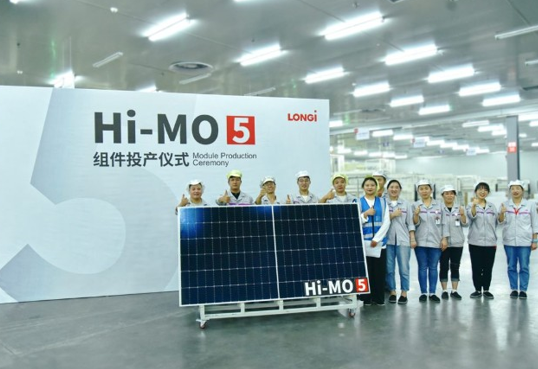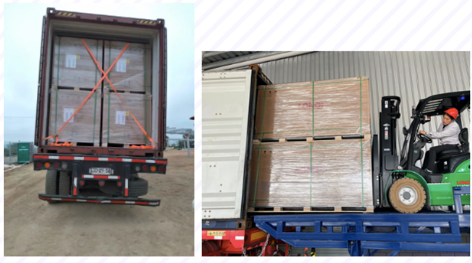
The solar industry has entered the large-format module era, with the joint efforts of leading manufacturers making power outputs in excess of 500W the new industry standard.
On 29 June 2020, LONGi officially launched its own iteration of next generation, high-power module, the Hi-MO 5, which boasts a power output 540W. This product is made of M10 silicon wafers with conversion efficiency of more than 21%.
Since then, more and more ultra-high power modules have been launched. In the past year, we have not stopped discussing the size of silicon wafers and modules and the discussion around size has never been as fierce as it is now.
In an exclusive interview with PV Tech, Dr. Jun Lv, vice president of LONGi business division, reflected on the launch of Hi-MO 5 almost a year ago, reviewing the R&D, production and marketing of large-size products.
Lv said that LONGi had dedicated considerable effort to studying the whole industry chain before determining the ideal size of the Hi-MO 5 product in terms of silicon wafer, cell, module, material, equipment, packaging and transportation, examining every aspect of the supply chain before committing to the M10 size.
LONGi’s assessment identified two of the largest bottlenecks in module manufacture and supply, those being the supply of raw materials and packaging and transportation. In terms of packaging and transportation, as the size of container is fixed, the best width is about 1130mm so as to maximize the available storage size. It is an approximate size, allowing a difference of just a few millimeters.
Lv said that in order to break the restriction, the R&D team had also developed some ambitious packaging and packing plans, which included putting the module upright into the container, so that the length can be made longer and the width is not limited. But it was later identified that this plan was too risky in terms of transportation, unloading and unpacking. If the module is too large and upright in the container, its centre of gravity will be relatively high, meaning that when the forklift goes in and out, a little displacement or uneven ground may cause the whole box of modules to fall over, taking the forklift with it.

“If the ground is not flat during the unpacking, the modules inside may fall over after the first one is taken out. It may cause personal injury. Because there is a risk in operation, we finally give up this plan. We will not transfer the risk to the transportation company, installers and other downstream enterprises. This is not the way we design the product. Therefore, we decide to use the conventional way of packaging,” Lv said.
The height of the universal container door is 2570mm. As the modules are loaded in two layers and there is an unloading space for forklift, LONGi and other manufacturers have determined the ideal width – approximately 1130mm – of large-size module (LONGi Hi-MO 5) in consideration of the height of the container door. At the same time, module reliability and transportation safety are verified to ensure that there are no problems during mass unloading and transportation.
Having discussed the launch of new products and sizes with other leading companies in the sector, Lv said it was intended to reach a consensus on wafer size and dimensions so as to streamline module manufacturing. “We hope to have a unified product size as the standard. If we use one size and the others use another, it will increase the cost of the whole industry,” Lv said.
Therefore, three leading companies – LONGi, JinkoSolar and JA Solar, together with other mainstream enterprises in the industry – jointly supported the size standard of M10 (182X182mm) for silicon wafers. Shortly afterwards, those three companies all announced that modules fitting to that M10 standard would enter mass production. The manufacturing capacity of M10 modules from LONGi, JinkoSolar and JA Solar is expected to stand at around 54GW this year, while by the end of 2021 total industry capacity of M10 modules may exceed 100GW.
At present, orders for these products have exceeded 20GW, with orders originating from nearly 30 different countries.
Focus on technology again to further improve efficiency and reduce costs
While it’s clear no consensus on size has been reached, the discussion has subsided for now. Instead, the industry has drawn its focus on the technology underpinning the module’s performance. This, Lv said, is vital for the industry to succeed.
“The industry shall go back to the technological innovation again to further improve the conversion efficiency and reduce the costs. We call on the industry to go back to the real technology competition road,” said Jun Lv.
Lv made it clear that as a PV module company, it is LONGi’s main task to further improve the conversion efficiency and reduce the cost of module per watt and power generation. Since the end of last year, LONGi’s management team has proposed to focus on efficiency in different occasions, adding that it would use M6 (166) and M10 (182) sizes over the next few years.
As a result, LONGi may launch modules with higher conversion efficiencies at this year’s SNEC exhibition in China, scheduled to take place between 3 – 5 June 2021, however protection against extreme weather events is also high on LONGi’s list of priorities.
“The modules have to generate power outdoors for 25 years. When they are used in large-scale power plants with relatively terrible weather conditions, such as strong wind, sandstorms, etc., the larger-size module will be under the greater force of wind as it has a larger windward side. It means that oversized modules will face a greater reliability risk,” Lv said.
Lv added that the basic principle of LONGi product design was “robustness and reliability” and any technological innovation shall ensure that the power plant could run for 25 or even 30 years and have a long-term benefit.
*Note: This interview was first published by PV Tech.
(https://www.pv-tech.org/longi-solar-industry-must-move-past-size-refocus-on-efficiency-and-innovation/)